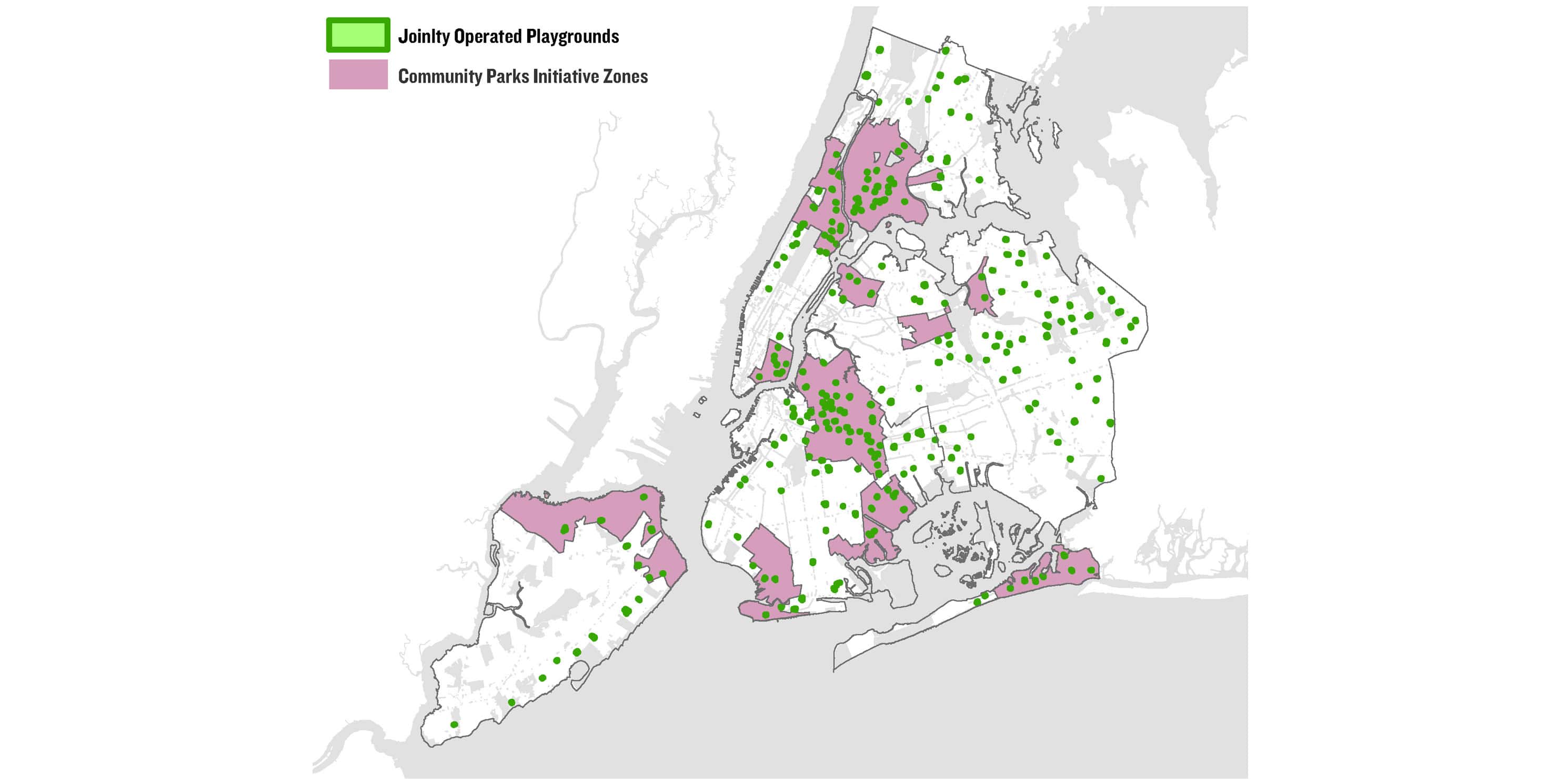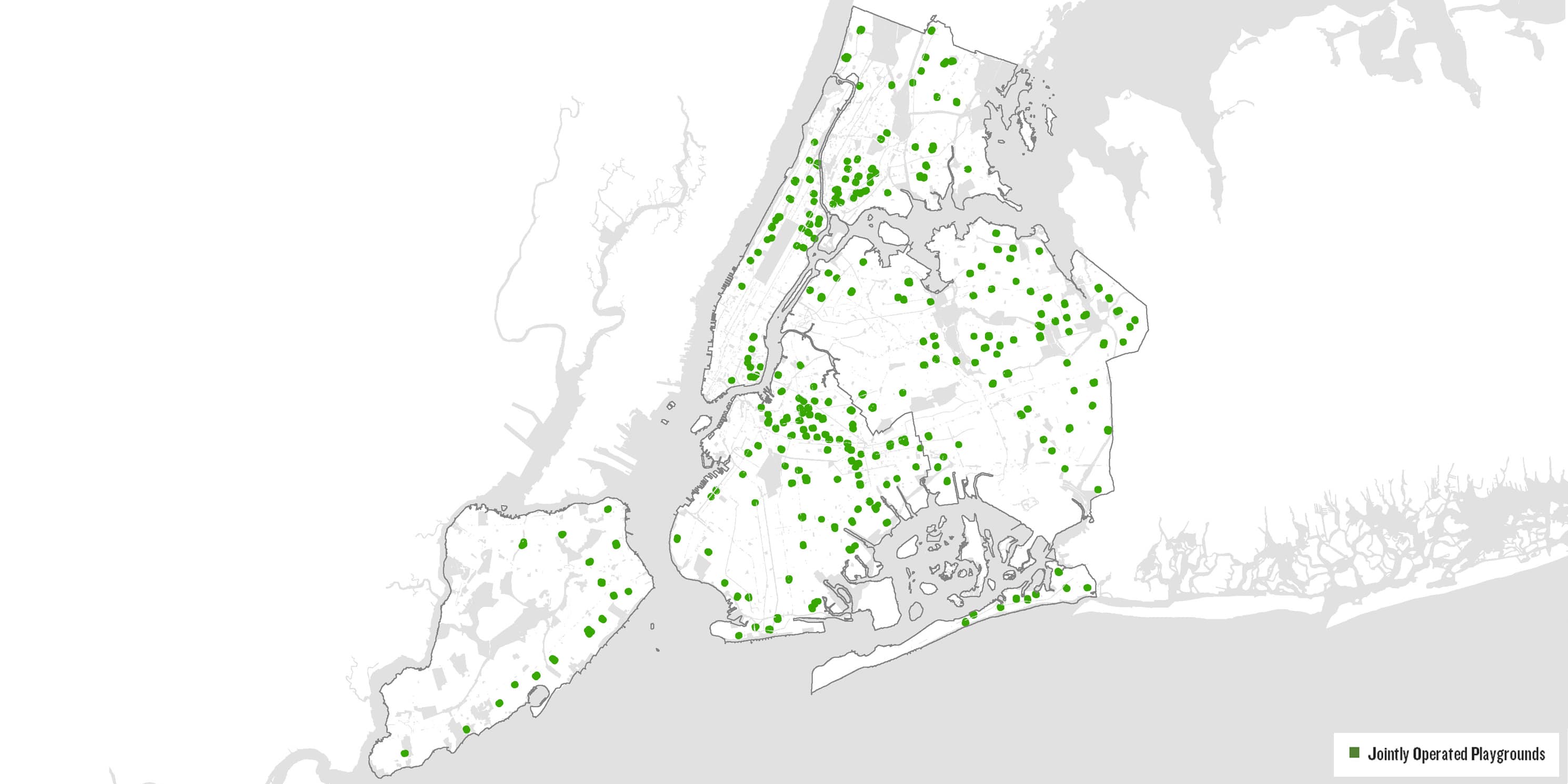City Council Must Enforce Protections for Jointly Operated Playgrounds
Testimony to the New York City Council Parks Committee
It is important to state right from the outset that MAS believes that balanced communities with adequate housing, schools, parks and other public amenities are what make New York City strong. We reject any implication that neighborhoods must choose schools over parks or parks over housing. The City has consistently acknowledged the importance of open space goals and improving park equity as a fundamental value.
Jointly Operated Playgrounds (JOPs) are crucial to the provision of quality, accessible parks in the city, particularly in underserved neighborhoods. We are before you today to make the case that JOPs are critical to the long-standing commitment that New York City has made to its neighborhoods, a commitment it must carry forth into the future.
Download TestimonyBackground
For 125 years, the Municipal Art Society of New York (MAS) has worked to educate and inspire New Yorkers to engage in the betterment of our city. As a non-profit advocacy organization, MAS mobilizes diverse allies to focus on issues that affect our city from sidewalk to skyline. Through three core campaign areas, MAS protects New York’s legacy spaces, encourages thoughtful planning and urban design, and fosters inclusive neighborhoods across the five boroughs.
Marx Brother Playground: A Negative Precedent
A recent development, initiated and approved by the City at the Marx Brothers Playground in East Harlem, sets a harmful precedent that may put JOPs at risk throughout the five boroughs. MAS, in partnership with several other prominent civic organizations, has filed a lawsuit to challenge the City’s actions which have effectively allocated development rights to Marx Brothers Playground, a public park, for the purpose of contributing them to a private developer’s 700-foot residential tower.
MAS, along with our coalition of partners at Carnegie Hill Neighbors, CIVITAS, the Friends of the Upper East Side Historic Districts, believes that both the process and the substance of the City’s determination were fatally flawed for multiple reasons. The first is that the City’s decision to assign development rights to a park is illegal and unprecedented. Parks do not have development rights and Marx Brothers Playground should not be an exception to the long-standing City policy. Second, the City has offered replacement open space that is inferior and could be developed for other purposes at any time. Lastly, the disclosures the City made throughout the process were at best confusing and, at worst, deliberately obscured the facts.
In the City’s formal response to the lawsuit, the Department of Parks and Recreation confirmed our deepest fears when it asserted that the City reserves the right to use JOPs for any purpose that it wishes.
Furthermore, the City contends that Marx Brothers Playground was never protected parkland. Despite this characterization, they took an alienation action to the State Legislature “in an abundance of caution.” The Governor stayed the implementation of the alienation pending a review of Marx Brothers Playground’s parkland status by the Commissioner of New York State’s Office of Parks, Recreation and Historic Preservation.
MAS strongly affirms the status of Marx Brothers Playground as “implied” parkland under the State’s definition and therefore demands the rigors of not just the alienation process but the commitment to replace in kind and VALUE, which is clearly not proposed as part of the current development plan.
This decision sets a very negative precedent with city-wide implications, putting 268 playgrounds across the five boroughs, including the 116 located in underserved neighborhoods, at risk of a similar fate.
In an effort to understand the implications of the potential development of the Marx Brothers Playground, MAS conducted a risk analysis of properties categorized as JOPs. Conditions leading to the potential development of Marx Brothers Playground involve a range of factors including (i) school overcrowding or school seat capacity, (ii) allowed zoning floor area, and (iii) assessed property value. Based on these factors, MAS assigned “risk points” to each JOP.
Based on this methodology, MAS identified 20 playgrounds that have comparable levels of risk to Marx Brothers Playground. Twelve out of the 20 playgrounds that score the highest risk are located in Upper Manhattan (Figure 2). This result can be attributed to the higher density zoning districts and property values of the Upper East and West Side neighborhoods. Five high-risk playgrounds are located in Brooklyn, two are in Queens, and one is in the Bronx. At least three JOPs would be considered to be at higher risk than Marx Brothers Playground: Washington Park in Gowanus, Brooklyn (with 16 pts), Grace Playground in East New York, Brooklyn (with 12 pts), and Happy Warrior Playground on the Upper West Side in Manhattan (with 12 pts).
Conclusion
MAS strongly believes that parks and open space are vital to livable neighborhoods. The status of Marx Brothers Playground has significant implications for New York City residents who want assurance that they will have access to outdoor recreation. Allowing developers to claim air rights from JOPs challenges the protections that parks should have in New York City. The action affecting Marx Brothers Playground has harmful implications for the city that puts all 268 JOPs at risk of becoming development sites. We urge the City Council to ensure that Jointly Operated Playgrounds are always treated as “implied” parkland from a procedural perspective.

